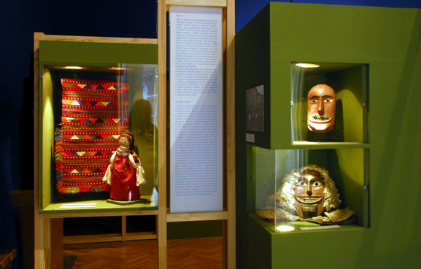Croat, Šokac, Bunjevac
REVIEW
The nations of Central Europe have been stratifying onto each other for many centuries. Their mixing is so complex, their separation and their effect on each other that only decisions made by world powers are able to create and change borders between them
| Götz Eszter |
2014-01-07 15:06 |

Folk customs, the identity manifesting itself in the culture of objects, taste dressed into colours, forms and substances does not know neither geographical, neither political boundaries.
The characteristic East European mixing in the Hungarian-Croatian relation is even more complex. The title of the new exhibition of the Museum of Ethnography indicates this: More, than neighbour.
A common state put the two nations together for centuries. The story and lifestyle of the two nations are identical in many ways. The art exhibition lets the visitor in on not only the ethnography Croatians but into all of the beauty of the every day life that springs from Croatian roots. Croatia's EU accession provides the occasion it is manifest from the installation that an old debt has been paid: the rich Croatian collection of the Museum of Ethnography was kept untouched for more than a century in the store rooms..
Many thousand objects were sifted and grouped and finally selected according to the regions of today’s Croatia in order to make it understandable how Dalmatian folk culture differs from that of the highland, how the folklore of the Adriatic coast or the Pannon region developed what kind of occupations formed the world of objects.
 The abundant substance was put into a logical, clear system by the curators Mónika Lackner, Ágnes Kerezsi and Sándor Horváth, but they let he effects working between the objects oscillate longer and this is what made the whole show full of life.
The abundant substance was put into a logical, clear system by the curators Mónika Lackner, Ágnes Kerezsi and Sándor Horváth, but they let he effects working between the objects oscillate longer and this is what made the whole show full of life.
The most exciting part for us was squeezed into the smallest space the culture of the Croatian ethnic groups living in the Hungary of today. The last hall is crammed with this material, although only a few objects are connected to the various ethnic groups. What Hungarian ethnography obtained from the Šokac, Bunjevac minorities or from the Croats of the region of the rivers Dráva and Mura, simply can’t be put together in such a small space.
The exhibition handles the question of minority culture in an understanding manner. So much so, that thinking further about the topic arises naturally. Maybe in a similarly methodic way and sensitivity it would be possible to plot it through a much bigger exhibition about
the relation system of the minorities living today in Hungary and their many layered relations with Hungarian folklore
The exhibition can be visited till March 23, 2014.